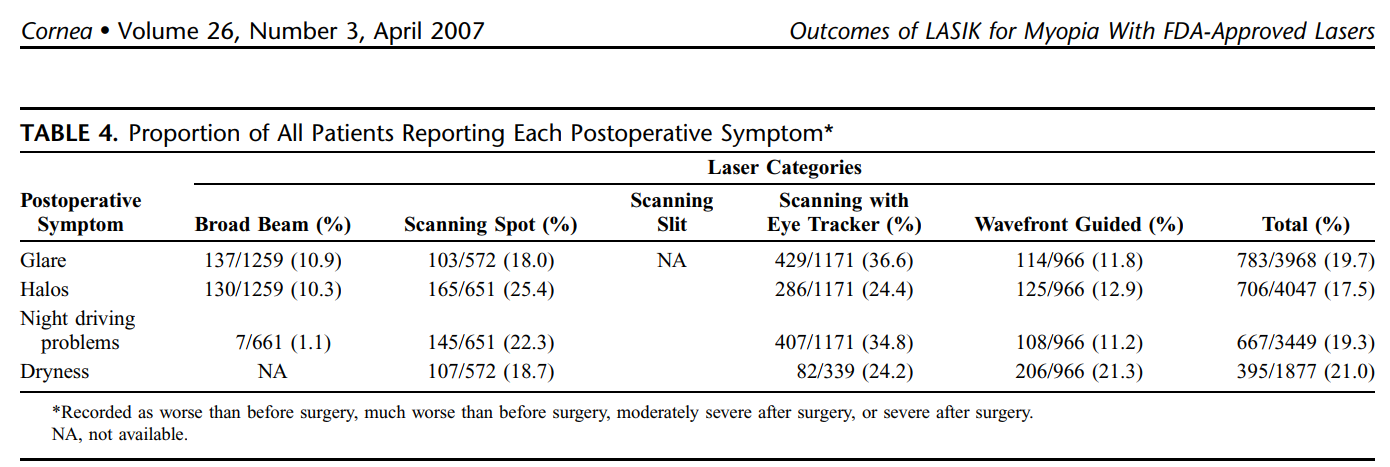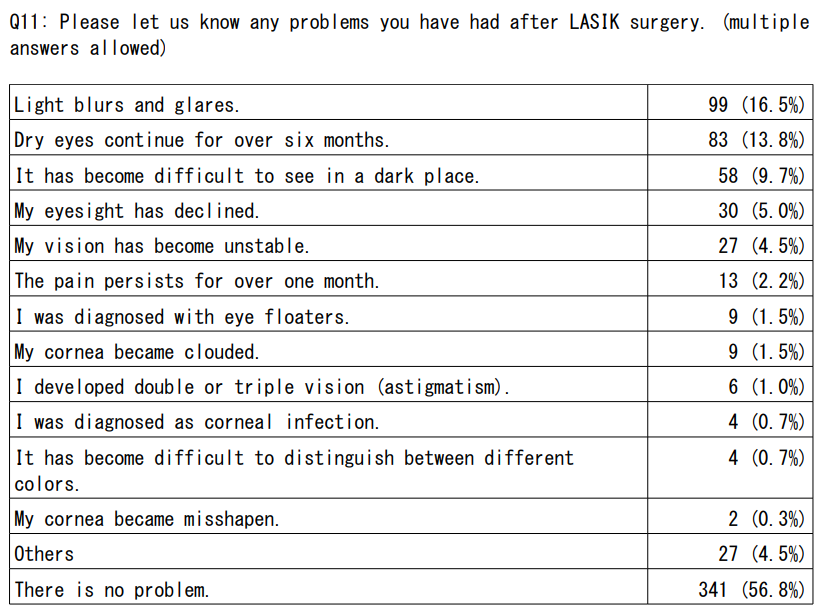Sources: LASIK Clinical Trials and Studies
PROWL: LASIK Quality of Life Collaboration Project (2017)
“Participants who developed new visual symptoms after surgery, most often developed halos. Up to 40 percent of participants with no halos before LASIK had halos three months following surgery.”
“Up to 28 percent of participants with no symptoms of dry eyes before LASIK, reported dry eye symptoms at three months after their surgery. This is consistent with previous studies.”
Read more: https://www.fda.gov/medical-devices/lasik/lasik-quality-life-collaboration-project
Since everyone keeps claiming LASIK is super safe and has a 99% success rate and keeps calling me a liar and a fear monger bc I say it's not and that the industry LIES, here's an ENTIRE thread of receipts (recreated with permission from one of my support groups):
— Chris Alvino (@ChrisAlvino) June 30, 2024
Laser in Situ Keratomileusis Outcomes and Complications: 2016 to 2023
Excerpt: “Eleven studies (5,637 eyes) reported the total postoperative prevalence of visual symptoms with a median follow-up of 6 months (range: 3 to 60 months) (Figure 5A). Among these, starburst was the most frequently reported visual disturbance (39.43%), followed by glare (28.22%). … Difficulty with night driving was reported by 15.45% of patients”

Source: Susanna BN, Mohan N, Santhiago MR, Randleman JB. Laser in Situ Keratomileusis Outcomes and Complications: 2016 to 2023. Journal of Refractive Surgery. 2025;41(4):e391-e403. doi:10.3928/1081597X-20250312-01
https://journals.healio.com/doi/10.3928/1081597X-20250312-01
Outcomes of LASIK for myopia with FDA-approved lasers
FDA clinical trials demonstrate alarming numbers of patients experience complications such as dry eyes and night vision problems after LASIK. A published review of data from twelve FDA clinical trials for LASIK, including newer “custom” “wavefront” technology, reveals that six months after LASIK:
- 17.5% of patients report halos
- 19.7% report glare (starbursts)
- 19.3% have night-driving problems
- 21% complain of eye dryness.
Source: Bailey MD, Zadnik K. Outcomes of LASIK for myopia with FDA-approved lasers. Cornea 2007 Apr;26(3):246-54.
Japan Consumer Affairs Agency Survey
- 43% reported problems (see Q11).
- One in four reported not having improved eyesight.
2025: Knowledge, Attitudes, and Practices Regarding Refractive Eye Surgeries Among Adults in the United Arab Emirates
Nearly 30% (n=40/135) of LASIK patients were left either partially satisfied or outright unsatisfied, proof that even “successful” surgeries often fall short of the perfect vision promised, leaving people with lingering regrets and unmet expectations.
A telling 35.56% (n=48/135) of patients who had LASIK/SMILE wouldn’t recommend refractive procedures to others.
Over 43% (n=59/135) of patients experienced at least one complication post-surgery, like dry eye (25.93%) or keratitis (17.04%)—highlighting that “no issues” is far from the norm, and the risks hit nearly half of those who go under the laser.
2025: Patient-Reported LASIK Outcomes on RealSelf: a Social Media Review Platform
- Nearly 1 in 4 LASIK patients reported negative or uncertain outcomes, with 22% saying it was “not worth it” or they were “not sure” about having had the surgery.
- Adverse effects were the #1 reason for negative reviews—43.5% of all negative reviews cited complications as the main issue.
- 66.7% of negative reviewers reported complications, showing that when LASIK goes wrong, it goes very wrong.
- Dry eye was the most common complication, reported by 17.2% of all patients and 32.4% of those with negative reviews.
- Halos and starbursts were frequently reported—21.3% of patients with adverse effects mentioned halos.
- Poor night vision occurred in 13.9% of negative reviewers and is a known LASIK-induced optical aberration that cannot always be corrected.
- Floaters and double vision also appeared uniquely in negative reviews, suggesting retinal stress or nerve problems.
- Pain was 10× more common in negative reviews (15.7%) than positive (1.4%), and pain persisted beyond recovery in many cases.
- Even among negative reviewers, patients sometimes reported 20/20 vision but still regretted the procedure due to side effects like dry eye and night blindness.
- RealSelf is a cosmetic surgery review platform where people speak openly—so this paper reveals reality without clinic filtering or industry bias.
- Patients were most likely to go negative when complications appeared regardless of visual results, proving that side effects destroy quality of life more than glasses ever could.
2023: Ocular Pain after Refractive Surgery: Interim Analysis of Frequency and Risk Factors
In this high quality study, 24% of patients reported eye pain at six months after laser eye surgery (LASIK and PRK), and 11% percent of individuals reported PERSISTENT eye pain at both, 3 months and 6 months after surgery. Source: https://pubmed.ncbi.nlm.nih.gov/36809816/
2025: Differences in pre-surgical baseline tear proteome are associated with persistent post-refractive surgery pain
2025 study shows nearly 40% of LASIK/PRK patients experience persistent eye pain after surgery.
2022: Phenotypic characterization of patients developing chronic dry eye and pain after refractive surgery: A cross-sectional study
Patients with severe DE also report specific symptoms of persistent and disabling pain, sometimes accompanied by hyperalgesia and allodynia. This set of symptoms is known as neuropathic ocular pain, corneal neuralgia, or keratoneuralgia [34], and there is a paucity of data regarding its prevalence and incidence. Levitt et al. [56] reported that 20–55% of their LASIK patients had at least mild symptoms of DE or persistent ocular pain




